
Lecture 7: Linear Models#
UBC 2023-24
Instructor: Varada Kolhatkar and Andrew Roth
Imports, Announcements, and LO#
Imports#
import os
import sys
sys.path.append("code/.")
import IPython
import ipywidgets as widgets
import matplotlib.pyplot as plt
import mglearn
import numpy as np
import pandas as pd
from IPython.display import HTML, display
from ipywidgets import interact, interactive
from plotting_functions import *
from sklearn.dummy import DummyClassifier
from sklearn.feature_extraction.text import CountVectorizer, TfidfVectorizer
from sklearn.impute import SimpleImputer
from sklearn.model_selection import cross_val_score, cross_validate, train_test_split
from sklearn.neighbors import KNeighborsClassifier, KNeighborsRegressor
from sklearn.pipeline import Pipeline, make_pipeline
from sklearn.preprocessing import OneHotEncoder, StandardScaler
from sklearn.svm import SVC
from sklearn.tree import DecisionTreeClassifier
from utils import *
%matplotlib inline
pd.set_option("display.max_colwidth", 200)
Announcements#
Homework 3 is due on Oct 2nd.
Learning outcomes#
From this lecture, students are expected to be able to:
Explain the general intuition behind linear models;
Explain how
predictworks for linear regression;Use
scikit-learn’sRidgemodel;Demonstrate how the
alphahyperparameter ofRidgeis related to the fundamental tradeoff;Explain the difference between linear regression and logistic regression;
Use
scikit-learn’sLogisticRegressionmodel andpredict_probato get probability scoresExplain the advantages of getting probability scores instead of hard predictions during classification;
Broadly describe linear SVMs
Explain how can you interpret model predictions using coefficients learned by a linear model;
Explain the advantages and limitations of linear classifiers.
Linear models [video]#
Linear models is a fundamental and widely used class of models. They are called linear because they make a prediction using a linear function of the input features.
We will talk about three linear models:
Linear regression
Logistic regression
Linear SVM (brief mention)
Linear regression#
A very popular statistical model and has a long history.
Imagine a hypothetical regression problem of predicting weight of a snake given its length.
np.random.seed(7)
n = 100
X_1 = np.linspace(0, 2, n) + np.random.randn(n) * 0.01
X = pd.DataFrame(X_1[:, None], columns=["length"])
y = abs(np.random.randn(n, 1)) * 3 + X_1[:, None] * 5 + 0.2
y = pd.DataFrame(y, columns=["weight"])
snakes_df = pd.concat([X, y], axis=1)
train_df, test_df = train_test_split(snakes_df, test_size=0.2, random_state=77)
X_train = train_df[["length"]].values
y_train = train_df["weight"].values
X_test = test_df[["length"]].values
y_test = test_df["weight"].values
train_df.head()
| length | weight | |
|---|---|---|
| 73 | 1.489130 | 10.507995 |
| 53 | 1.073233 | 7.658047 |
| 80 | 1.622709 | 9.748797 |
| 49 | 0.984653 | 9.731572 |
| 23 | 0.484937 | 3.016555 |
Let’s visualize the hypothetical snake data.
plt.plot(X_train, y_train, ".", markersize=10)
plt.xlabel("length")
plt.ylabel("weight (target)");
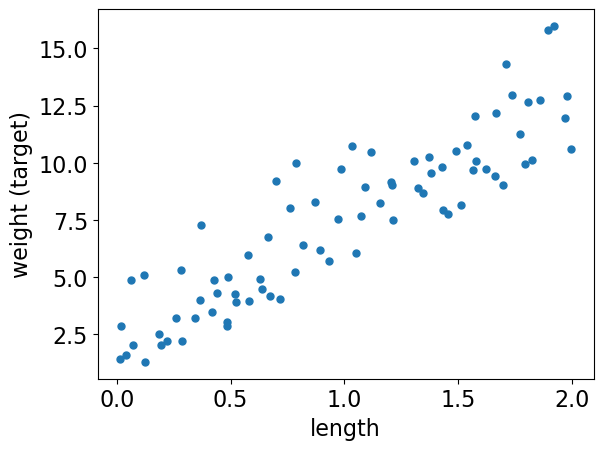
Let’s plot a linear regression model on this dataset.
grid = np.linspace(min(X_train)[0], max(X_train)[0], 1000)
grid = grid.reshape(-1, 1)
from sklearn.linear_model import Ridge
r = Ridge()
r.fit(X_train, y_train)
plt.plot(X_train, y_train, ".", markersize=10)
plt.plot(grid, r.predict(grid))
plt.grid(True)
plt.xlabel("length")
plt.ylabel("weight (target)");
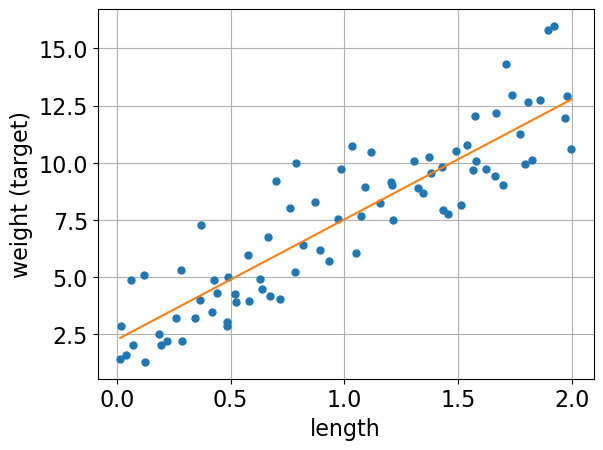
The orange line is the learned linear model.
Prediction of linear regression#
Given a snake length, we can use the model above to predict the target (i.e., the weight of the snake).
The prediction will be the corresponding weight on the orange line.
snake_length = 0.75
r.predict([[snake_length]])
array([6.20683258])
What are we exactly learning?#
The model above is a line, which can be represented with a slope (i.e., coefficient or weight) and an intercept.
For the above model, we can access the slope (i.e., coefficient or weight) and the intercept using
coef_andintercept_, respectively.
r.coef_ # r is our linear regression object
array([5.26370005])
r.intercept_ # r is our linear regression object
2.259057547817185
How are we making predictions?#
Given a feature value \(x_1\) and learned coefficient \(w_1\) and intercept \(b\), we can get the prediction \(\hat{y}\) with the following formula: $\(\hat{y} = w_1x_1 + b\)$
prediction = snake_length * r.coef_ + r.intercept_
prediction
array([6.20683258])
r.predict([[snake_length]])
array([6.20683258])
Great! Now we exactly know how the model is making the prediction.
Generalizing to more features#
For more features, the model is a higher dimensional hyperplane and the general prediction formula looks as follows:
\(\hat{y} =\) \(w_1\) \(x_1\) \(+ \dots +\) \(w_d\) \(x_d\) + \(b\)
where,
(\(x_1, \dots, x_d\)) are input features
(\(w_1, \dots, w_d\)) are coefficients or weights (learned from the data)
\(b\) is the bias which can be used to offset your hyperplane (learned from the data)
Example#
Suppose these are the coefficients learned by a linear regression model on a hypothetical housing price prediction dataset.
Feature |
Learned coefficient |
|---|---|
Bedrooms |
0.20 |
Bathrooms |
0.11 |
Square Footage |
0.002 |
Age |
-0.02 |
Now given a new example, the target will be predicted as follows: | Bedrooms | Bathrooms | Square Footage | Age | |——————–|———————|—————-|—–| | 3 | 2 | 1875 | 66 |
When we call fit, a coefficient or weight is learned for each feature which tells us the role of that feature in prediction. These coefficients are learned from the training data.
Important
In linear models for regression, the model is a line for a single feature, a plane for two features, and a hyperplane for higher dimensions. We are not yet ready to discuss how does linear regression learn these coefficients and intercept.
Ridge#
scikit-learnhas a model calledLinearRegressionfor linear regression.But if we use this “vanilla” version of linear regression, it may result in large coefficients and unexpected results.
So instead of using
LinearRegression, we will always use another linear model calledRidge, which is a linear regression model with a complexity hyperparameteralpha.
from sklearn.linear_model import LinearRegression # DO NOT USE IT IN THIS COURSE
from sklearn.linear_model import Ridge # USE THIS INSTEAD
Data#
Let’s use sklearn’s built in regression dataset, the Boston Housing dataset. The task associated with this dataset is to predict the median value of homes in several Boston neighborhoods in the 1970s, using information such as crime rate in the neighbourhood, average number of rooms, proximity to the Charles River, highway accessibility, and so on.
from sklearn.datasets import fetch_california_housing
california = fetch_california_housing()
X_train, X_test, y_train, y_test = train_test_split(
california.data, california.target, test_size=0.2
)
pd.DataFrame(X_train, columns=california.feature_names)
| MedInc | HouseAge | AveRooms | AveBedrms | Population | AveOccup | Latitude | Longitude | |
|---|---|---|---|---|---|---|---|---|
| 0 | 2.0000 | 52.0 | 5.303030 | 1.082251 | 725.0 | 3.138528 | 38.03 | -121.88 |
| 1 | 2.0000 | 52.0 | 5.506410 | 1.134615 | 1026.0 | 3.288462 | 34.00 | -118.30 |
| 2 | 4.0474 | 30.0 | 5.419355 | 1.006452 | 858.0 | 2.767742 | 37.31 | -121.94 |
| 3 | 3.2794 | 7.0 | 5.546473 | 1.044166 | 5146.0 | 3.392221 | 34.46 | -117.20 |
| 4 | 2.5551 | 35.0 | 4.018487 | 1.016807 | 1886.0 | 3.169748 | 37.35 | -121.86 |
| ... | ... | ... | ... | ... | ... | ... | ... | ... |
| 16507 | 3.0185 | 17.0 | 4.205479 | 0.863014 | 434.0 | 1.981735 | 34.61 | -120.16 |
| 16508 | 12.6320 | 5.0 | 7.462963 | 0.888889 | 208.0 | 3.851852 | 34.44 | -119.31 |
| 16509 | 3.9808 | 20.0 | 5.678689 | 1.006557 | 999.0 | 3.275410 | 38.28 | -121.20 |
| 16510 | 5.8195 | 25.0 | 6.585513 | 0.961771 | 1645.0 | 3.309859 | 33.71 | -117.97 |
| 16511 | 3.7315 | 20.0 | 7.368304 | 1.738839 | 1085.0 | 2.421875 | 37.58 | -118.74 |
16512 rows × 8 columns
print(california.DESCR)
.. _california_housing_dataset:
California Housing dataset
--------------------------
**Data Set Characteristics:**
:Number of Instances: 20640
:Number of Attributes: 8 numeric, predictive attributes and the target
:Attribute Information:
- MedInc median income in block group
- HouseAge median house age in block group
- AveRooms average number of rooms per household
- AveBedrms average number of bedrooms per household
- Population block group population
- AveOccup average number of household members
- Latitude block group latitude
- Longitude block group longitude
:Missing Attribute Values: None
This dataset was obtained from the StatLib repository.
https://www.dcc.fc.up.pt/~ltorgo/Regression/cal_housing.html
The target variable is the median house value for California districts,
expressed in hundreds of thousands of dollars ($100,000).
This dataset was derived from the 1990 U.S. census, using one row per census
block group. A block group is the smallest geographical unit for which the U.S.
Census Bureau publishes sample data (a block group typically has a population
of 600 to 3,000 people).
A household is a group of people residing within a home. Since the average
number of rooms and bedrooms in this dataset are provided per household, these
columns may take surprisingly large values for block groups with few households
and many empty houses, such as vacation resorts.
It can be downloaded/loaded using the
:func:`sklearn.datasets.fetch_california_housing` function.
.. topic:: References
- Pace, R. Kelley and Ronald Barry, Sparse Spatial Autoregressions,
Statistics and Probability Letters, 33 (1997) 291-297
Ridge on the California housing dataset#
pipe = make_pipeline(StandardScaler(), Ridge())
scores = cross_validate(pipe, X_train, y_train, return_train_score=True)
pd.DataFrame(scores)
| fit_time | score_time | test_score | train_score | |
|---|---|---|---|---|
| 0 | 0.006541 | 0.000512 | 0.599492 | 0.608050 |
| 1 | 0.002695 | 0.000391 | 0.613507 | 0.604619 |
| 2 | 0.002454 | 0.000362 | 0.598100 | 0.608468 |
| 3 | 0.002432 | 0.000355 | 0.612621 | 0.604797 |
| 4 | 0.002944 | 0.000456 | 0.601790 | 0.606902 |
Hyperparameter alpha of Ridge#
Ridge has hyperparameters just like the rest of the models we learned.
The alpha hyperparameter is what makes
Ridgedifferent from vanillaLinearRegression.Similar to the other hyperparameters that we saw,
alphacontrols the fundamental tradeoff.
Note
If we set alpha=0 that is the same as using LinearRegression.
Let’s examine the effect of alpha on the fundamental tradeoff.
scores_dict = {
"alpha": 10.0 ** np.arange(-3, 6, 1),
"mean_train_scores": list(),
"mean_cv_scores": list(),
}
for alpha in scores_dict["alpha"]:
pipe_ridge = make_pipeline(StandardScaler(), Ridge(alpha=alpha))
scores = cross_validate(pipe_ridge, X_train, y_train, return_train_score=True)
scores_dict["mean_train_scores"].append(scores["train_score"].mean())
scores_dict["mean_cv_scores"].append(scores["test_score"].mean())
results_df = pd.DataFrame(scores_dict)
results_df
| alpha | mean_train_scores | mean_cv_scores | |
|---|---|---|---|
| 0 | 0.001 | 0.606567 | 0.605101 |
| 1 | 0.010 | 0.606567 | 0.605101 |
| 2 | 0.100 | 0.606567 | 0.605101 |
| 3 | 1.000 | 0.606567 | 0.605102 |
| 4 | 10.000 | 0.606557 | 0.605100 |
| 5 | 100.000 | 0.605696 | 0.604320 |
| 6 | 1000.000 | 0.579432 | 0.578523 |
| 7 | 10000.000 | 0.431137 | 0.430868 |
| 8 | 100000.000 | 0.116167 | 0.115956 |
Here we do not really see overfitting but in general,
larger
alpha\(\rightarrow\) likely to underfitsmaller
alpha\(\rightarrow\) likely to overfit
Coefficients and intercept#
The model learns
coefficients associated with each feature
the intercept or bias
Let’s examine the coefficients learned by the model.
pipe_ridge = make_pipeline(StandardScaler(), Ridge(alpha=1.0))
pipe_ridge.fit(X_train, y_train)
coeffs = pipe_ridge.named_steps["ridge"].coef_
pd.DataFrame(data=coeffs, index=california.feature_names, columns=["Coefficients"])
| Coefficients | |
|---|---|
| MedInc | 0.827039 |
| HouseAge | 0.117058 |
| AveRooms | -0.265273 |
| AveBedrms | 0.307521 |
| Population | -0.003194 |
| AveOccup | -0.039498 |
| Latitude | -0.895963 |
| Longitude | -0.866110 |
The model also learns an intercept (bias).
For each prediction, we are adding this amount irrespective of the feature values.
pipe_ridge.named_steps["ridge"].intercept_
2.0667579112160865
Can we use this information to interpret model predictions?
❓❓ Questions for you#
(iClicker) Exercise 7.1#
iClicker cloud join link: https://join.iclicker.com/3DP5H
Select all of the following statements which are TRUE.
(A) Increasing the hyperparameter
alphaofRidgeis likely to decrease model complexity.(B)
Ridgecan be used with datasets that have multiple features.(C) With Ridge, we learn one coefficient per training example.
(D) If you train a linear regression model on a 2-dimensional problem (2 features), the model will learn 3 parameters: one for each feature and one for the bias term.
Interpretation of coefficients#
One of the main advantages of linear models is that they are relatively easy to interpret.
We have one coefficient per feature which kind of describes the role of the feature in the prediction according to the model.
There are two pieces of information in the coefficients based on
Sign
Magnitude
Sign of the coefficients#
In the example below, for instance:
MedInc (median income) has a positive coefficient
the prediction will be proportional to the feature value; as MedInc gets bigger, the median house value gets bigger
AveRooms (Average number of rooms) has a negative coefficient
the prediction will be inversely proportional to the feature value; as AveRooms gets bigger, the median house value gets smaller
pd.DataFrame(data=coeffs, index=california.feature_names, columns=["Coefficients"])
| Coefficients | |
|---|---|
| MedInc | 0.827039 |
| HouseAge | 0.117058 |
| AveRooms | -0.265273 |
| AveBedrms | 0.307521 |
| Population | -0.003194 |
| AveOccup | -0.039498 |
| Latitude | -0.895963 |
| Longitude | -0.866110 |
Magnitude of the coefficients#
Bigger magnitude \(\rightarrow\) bigger impact on the prediction
In the example below, both MedInc and AveBedrms have a positive impact on the prediction but MedInc would have a bigger positive impact because it’s feature value is going to be multiplied by a number with a bigger magnitude.
data = {
"coefficient": pipe_ridge.named_steps["ridge"].coef_.tolist(),
"magnitude": np.absolute(pipe_ridge.named_steps["ridge"].coef_.tolist()),
}
coef_df = pd.DataFrame(data, index=california.feature_names).sort_values(
"magnitude", ascending=False
)
coef_df
| coefficient | magnitude | |
|---|---|---|
| Latitude | -0.895963 | 0.895963 |
| Longitude | -0.866110 | 0.866110 |
| MedInc | 0.827039 | 0.827039 |
| AveBedrms | 0.307521 | 0.307521 |
| AveRooms | -0.265273 | 0.265273 |
| HouseAge | 0.117058 | 0.117058 |
| AveOccup | -0.039498 | 0.039498 |
| Population | -0.003194 | 0.003194 |
Importance of scaling#
When you are interpreting the model coefficients, scaling is crucial.
If you do not scale the data, features with smaller magnitude are going to get coefficients with bigger magnitude whereas features with bigger scale are going to get coefficients with smaller magnitude.
That said, when you scale the data, feature values become hard to interpret for humans!
Important
Take these coefficients with a grain of salt. They might not always match your intuitions. Also, they do not tell us about how the world works. They only tell us about how the prediction of your model works.
❓❓ Questions for you#
Discuss the importance of scaling when interpreting linear regression coefficients.
What might be the meaning of complex vs simpler model in case of linear regression?
Logistic regression [video]#
Logistic regression intuition#
A linear model for classification.
Similar to linear regression, it learns weights associated with each feature and the bias.
It applies a threshold on the raw output to decide whether the class is positive or negative.
In this lecture we will focus on the following aspects of logistic regression.
predict,predict_probahow to use learned coefficients to interpret the model
Motivating example#
Consider the problem of predicting sentiment expressed in movie reviews.
Training data for the motivating example#
Review 1: This movie was excellent! The performances were oscar-worthy! 👍
Review 2: What a boring movie! I almost fell asleep twice while watching it. 👎
Review 3: I enjoyed the movie. Excellent! 👍
Targets: positive 👍 and negative 👎
Features: words (e.g., excellent, flawless, boring)
Learned coefficients associated with all features#
Suppose our vocabulary contains only the following 7 words.
A linear classifier learns weights or coefficients associated with the features (words in this example).
Let’s ignore bias for a bit.
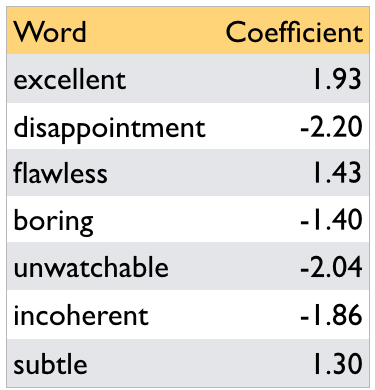
Predicting with learned weights#
Use these learned coefficients to make predictions. For example, consider the following review \(x_i\).
It got a bit boring at times but the direction was excellent and the acting was flawless.- Feature vector for $x_i$: [1, 0, 1, 1, 0, 0, 0]

\(score(x_i) = \) coefficient(boring) \(\times 1\) + coefficient(excellent) \(\times 1\) + coefficient(flawless) \(\times 1\) = \(-1.40 + 1.93 + 1.43 = 1.96\)
\(1.96 > 0\) so predict the review as positive 👍.
x = ["boring=1", "excellent=1", "flawless=1"]
w = [-1.40, 1.93, 1.43]
display(plot_logistic_regression(x, w))
Weighted sum of the input features = 1.960 y_hat = pos
So the prediction is based on the weighted sum of the input features.
Some feature are pulling the prediction towards positive sentiment and some are pulling it towards negative sentiment.
If the coefficient of boring had a bigger magnitude or excellent and flawless had smaller magnitudes, we would have predicted “neg”.
def f(w_0):
x = ["boring=1", "excellent=1", "flawless=1"]
w = [-1.40, 1.93, 1.43]
w[0] = w_0
print(w)
display(plot_logistic_regression(x, w))
interactive(
f,
w_0=widgets.FloatSlider(min=-6, max=2, step=0.5, value=-1.40),
)
In our case, for values for the coefficient of boring < -3.36, the prediction would be negative.
A linear model learns these coefficients or weights from the training data!
So a linear classifier is a linear function of the input X, followed by a threshold.
Components of a linear classifier#
input features (\(x_1, \dots, x_d\))
coefficients (weights) (\(w_1, \dots, w_d\))
bias (\(b\) or \(w_0\)) (can be used to offset your hyperplane)
threshold (\(r\))
In our example before, we assumed \(r=0\) and \(b=0\).
Logistic regression on the cities data#
cities_df = pd.read_csv("data/canada_usa_cities.csv")
train_df, test_df = train_test_split(cities_df, test_size=0.2, random_state=123)
X_train, y_train = train_df.drop(columns=["country"]).values, train_df["country"].values
X_test, y_test = test_df.drop(columns=["country"]).values, test_df["country"].values
cols = train_df.drop(columns=["country"]).columns
train_df.head()
| longitude | latitude | country | |
|---|---|---|---|
| 160 | -76.4813 | 44.2307 | Canada |
| 127 | -81.2496 | 42.9837 | Canada |
| 169 | -66.0580 | 45.2788 | Canada |
| 188 | -73.2533 | 45.3057 | Canada |
| 187 | -67.9245 | 47.1652 | Canada |
Let’s first try DummyClassifier on the cities data.
dummy = DummyClassifier()
scores = cross_validate(dummy, X_train, y_train, return_train_score=True)
pd.DataFrame(scores)
| fit_time | score_time | test_score | train_score | |
|---|---|---|---|---|
| 0 | 0.000420 | 0.000757 | 0.588235 | 0.601504 |
| 1 | 0.000168 | 0.000261 | 0.588235 | 0.601504 |
| 2 | 0.000160 | 0.000255 | 0.606061 | 0.597015 |
| 3 | 0.000113 | 0.000199 | 0.606061 | 0.597015 |
| 4 | 0.000109 | 0.000189 | 0.606061 | 0.597015 |
Now let’s try LogisticRegression
from sklearn.linear_model import LogisticRegression
lr = LogisticRegression()
scores = cross_validate(lr, X_train, y_train, return_train_score=True)
pd.DataFrame(scores)
| fit_time | score_time | test_score | train_score | |
|---|---|---|---|---|
| 0 | 0.005852 | 0.000337 | 0.852941 | 0.827068 |
| 1 | 0.002138 | 0.000257 | 0.823529 | 0.827068 |
| 2 | 0.001907 | 0.000257 | 0.696970 | 0.858209 |
| 3 | 0.001977 | 0.000259 | 0.787879 | 0.843284 |
| 4 | 0.002188 | 0.000259 | 0.939394 | 0.805970 |
Logistic regression seems to be doing better than dummy classifier. But note that there is a lot of variation in the scores.
Accessing learned parameters#
Recall that logistic regression learns the weights \(w\) and bias or intercept \(b\).
How to access these weights?
Similar to
Ridge, we can access the weights and intercept usingcoef_andintercept_attribute of theLogisticRegressionobject, respectively.
lr = LogisticRegression()
lr.fit(X_train, y_train)
print("Model weights: %s" % (lr.coef_)) # these are the learned weights
print("Model intercept: %s" % (lr.intercept_)) # this is the bias term
data = {"features": cols, "coefficients": lr.coef_[0]}
pd.DataFrame(data)
Model weights: [[-0.04108149 -0.33683126]]
Model intercept: [10.8869838]
| features | coefficients | |
|---|---|---|
| 0 | longitude | -0.041081 |
| 1 | latitude | -0.336831 |
Both negative weights
The weight of latitude is larger in magnitude.
This makes sense because Canada as a country lies above the USA and so we expect latitude values to contribute more to a prediction than longitude.
Prediction with learned parameters#
Let’s predict target of a test example.
example = X_test[0, :]
example
array([-64.8001, 46.098 ])
Raw scores#
Calculate the raw score as:
y_hat = np.dot(w, x) + b
(
np.dot(
example,
lr.coef_.reshape(
2,
),
)
+ lr.intercept_
)
array([-1.97817876])
Apply the threshold to the raw score.
Since the prediction is < 0, predict “negative”.
What is a “negative” class in our context?
With logistic regression, the model randomly assigns one of the classes as a positive class and the other as negative.
Usually it would alphabetically order the target and pick the first one as negative and second one as the positive class.
The
classes_attribute tells us which class is considered negative and which one is considered positive. - In this case, Canada is the negative class and USA is a positive class.
lr.classes_
array(['Canada', 'USA'], dtype=object)
So based on the negative score above (-1.978), we would predict Canada.
Let’s check the prediction given by the model.
lr.predict([example])
array(['Canada'], dtype=object)
Great! The predictions match! We exactly know how the model is making predictions.
Decision boundary of logistic regression#
The decision boundary of logistic regression is a hyperplane dividing the feature space in half.
lr = LogisticRegression()
lr.fit(X_train, y_train)
mglearn.discrete_scatter(X_train[:, 0], X_train[:, 1], y_train)
mglearn.plots.plot_2d_separator(lr, X_train, fill=False, eps=0.5, alpha=0.7)
plt.title(lr.__class__.__name__)
plt.xlabel("longitude")
plt.ylabel("latitude");
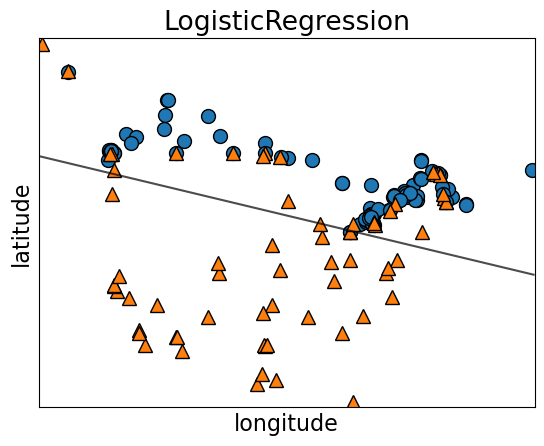
For \(d=2\), the decision boundary is a line (1-dimensional)
For \(d=3\), the decision boundary is a plane (2-dimensional)
For \(d\gt 3\), the decision boundary is a \(d-1\)-dimensional hyperplane
fig, axes = plt.subplots(1, 3, figsize=(20, 5))
for model, ax in zip(
[KNeighborsClassifier(), SVC(gamma=0.01), LogisticRegression()], axes
):
clf = model.fit(X_train, y_train)
mglearn.plots.plot_2d_separator(
clf, X_train, fill=True, eps=0.5, ax=ax, alpha=0.4
)
mglearn.discrete_scatter(X_train[:, 0], X_train[:, 1], y_train, ax=ax)
ax.set_title(clf.__class__.__name__)
ax.set_xlabel("longitude")
ax.set_ylabel("latitude")
axes[0].legend();

Notice a linear decision boundary (a line in our case).
Compare it with KNN or SVM RBF decision boundaries.
Main hyperparameter of logistic regression#
Cis the main hyperparameter which controls the fundamental trade-off.We won’t really talk about the interpretation of this hyperparameter right now.
At a high level, the interpretation is similar to
Cof SVM RBFsmaller
C\(\rightarrow\) might lead to underfittingbigger
C\(\rightarrow\) might lead to overfitting
scores_dict = {
"C": 10.0 ** np.arange(-4, 6, 1),
"mean_train_scores": list(),
"mean_cv_scores": list(),
}
for C in scores_dict["C"]:
lr = LogisticRegression(C=C)
scores = cross_validate(lr, X_train, y_train, return_train_score=True)
scores_dict["mean_train_scores"].append(scores["train_score"].mean())
scores_dict["mean_cv_scores"].append(scores["test_score"].mean())
results_df = pd.DataFrame(scores_dict)
results_df
| C | mean_train_scores | mean_cv_scores | |
|---|---|---|---|
| 0 | 0.0001 | 0.664707 | 0.658645 |
| 1 | 0.0010 | 0.784424 | 0.790731 |
| 2 | 0.0100 | 0.827842 | 0.826203 |
| 3 | 0.1000 | 0.832320 | 0.820143 |
| 4 | 1.0000 | 0.832320 | 0.820143 |
| 5 | 10.0000 | 0.832320 | 0.820143 |
| 6 | 100.0000 | 0.832320 | 0.820143 |
| 7 | 1000.0000 | 0.832320 | 0.820143 |
| 8 | 10000.0000 | 0.832320 | 0.820143 |
| 9 | 100000.0000 | 0.832320 | 0.820143 |
Predicting probability scores [video]#
predict_proba#
So far in the context of classification problems, we focused on getting “hard” predictions.
Very often it’s useful to know “soft” predictions, i.e., how confident the model is with a given prediction.
For most of the
scikit-learnclassification models we can access this confidence score or probability score using a method calledpredict_proba.
Let’s look at probability scores of logistic regression model for our test example.
example
array([-64.8001, 46.098 ])
lr = LogisticRegression(random_state=123)
lr.fit(X_train, y_train)
lr.predict([example]) # hard prediction
array(['Canada'], dtype=object)
lr.predict_proba([example]) # soft prediction
array([[0.87848688, 0.12151312]])
The output of
predict_probais the probability of each class.In binary classification, we get probabilities associated with both classes (even though this information is redundant).
The first entry is the estimated probability of the first class and the second entry is the estimated probability of the second class from
model.classes_.
lr.classes_
array(['Canada', 'USA'], dtype=object)
Because it’s a probability, the sum of the entries for both classes should always sum to 1.
Since the probabilities for the two classes sum to 1, exactly one of the classes will have a score >=0.5, which is going to be our predicted class.
How does logistic regression calculate these probabilities?#
The weighted sum \(w_1x_1 + \dots + w_dx_d + b\) gives us “raw model output”.
For linear regression this would have been the prediction.
For logistic regression, you check the sign of this value.
If positive (or 0), predict \(+1\); if negative, predict \(-1\).
These are “hard predictions”.
You can also have “soft predictions”, aka predicted probabilities.
To convert the raw model output into probabilities, instead of taking the sign, we apply the sigmoid.
The sigmoid function#
The sigmoid function “squashes” the raw model output from any number to the range \([0,1]\) using the following formula, where \(x\) is the raw model output. $\(\frac{1}{1+e^{-x}}\)$
Then we can interpret the output as probabilities.
sigmoid = lambda x: 1 / (1 + np.exp(-x))
raw_model_output = np.linspace(-8, 8, 1000)
plt.plot(raw_model_output, sigmoid(raw_model_output))
plt.plot([0, 0], [0, 0.5], "--k")
plt.plot([-8, 0], [0.5, 0.5], "--k")
plt.xlabel("raw model output, $w^Tx$")
plt.ylabel("predicted probability")
plt.title("the sigmoid function");
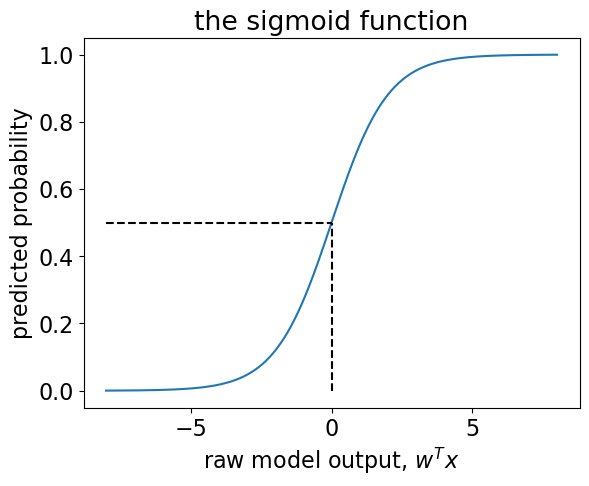
Recall our hard predictions that check the sign of \(w^Tx\), or, in other words, whether or not it is \(\geq 0\).
The threshold \(w^Tx=0\) corresponds to \(p=0.5\).
In other words, if our predicted probability is \(\geq 0.5\) then our hard prediction is \(+1\).
Let’s get the probability score by calling sigmoid on the raw model output for our test example.
sigmoid(
np.dot(
example,
lr.coef_.reshape(
2,
),
)
+ lr.intercept_
)
array([0.12151312])
This is the probability score of the positive class, which is USA.
lr.predict_proba([example])
array([[0.87848688, 0.12151312]])
With predict_proba, we get the same probability score for USA!!
Let’s visualize probability scores for some examples.
data_dict = {
"y": y_train[:12],
"y_hat": lr.predict(X_train[:12]).tolist(),
"probabilities": lr.predict_proba(X_train[:12]).tolist(),
}
pd.DataFrame(data_dict)
| y | y_hat | probabilities | |
|---|---|---|---|
| 0 | Canada | Canada | [0.7046068097086478, 0.2953931902913523] |
| 1 | Canada | Canada | [0.5630169062040135, 0.43698309379598654] |
| 2 | Canada | Canada | [0.8389680973255862, 0.16103190267441386] |
| 3 | Canada | Canada | [0.7964150775404333, 0.20358492245956678] |
| 4 | Canada | Canada | [0.901080665234097, 0.09891933476590302] |
| 5 | Canada | Canada | [0.7753006388010788, 0.22469936119892117] |
| 6 | USA | USA | [0.030740704606528224, 0.9692592953934718] |
| 7 | Canada | Canada | [0.6880304799160926, 0.3119695200839075] |
| 8 | Canada | Canada | [0.7891358587234142, 0.21086414127658581] |
| 9 | USA | USA | [0.006546969753885579, 0.9934530302461144] |
| 10 | USA | USA | [0.2787419584843105, 0.7212580415156895] |
| 11 | Canada | Canada | [0.8388877146644935, 0.16111228533550653] |
The actual y and y_hat match in most of the cases but in some cases the model is more confident about the prediction than others.
Least confident cases#
Let’s examine some cases where the model is least confident about the prediction.
least_confident_X = X_train[[127, 141]]
least_confident_X
array([[ -79.7599, 43.6858],
[-123.078 , 48.9854]])
least_confident_y = y_train[[127, 141]]
least_confident_y
array(['Canada', 'USA'], dtype=object)
probs = lr.predict_proba(least_confident_X)
data_dict = {
"y": least_confident_y,
"y_hat": lr.predict(least_confident_X).tolist(),
"probability score (Canada)": probs[:, 0],
"probability score (USA)": probs[:, 1],
}
pd.DataFrame(data_dict)
| y | y_hat | probability score (Canada) | probability score (USA) | |
|---|---|---|---|---|
| 0 | Canada | Canada | 0.634392 | 0.365608 |
| 1 | USA | Canada | 0.635666 | 0.364334 |
mglearn.discrete_scatter(
least_confident_X[:, 0],
least_confident_X[:, 1],
least_confident_y,
markers="o",
)
mglearn.plots.plot_2d_separator(lr, X_train, fill=True, eps=0.5, alpha=0.5)
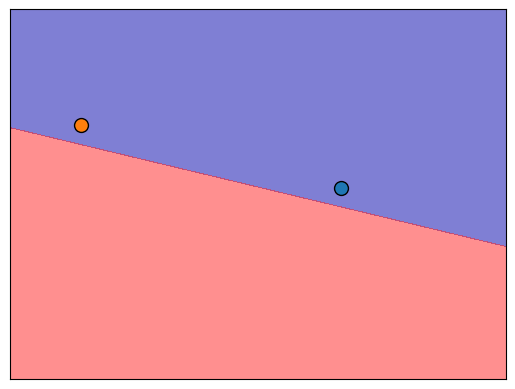
The points are close to the decision boundary which makes sense.
Most confident cases#
Let’s examine some cases where the model is most confident about the prediction.
most_confident_X = X_train[[37, 4]]
most_confident_X
array([[-110.9748, 32.2229],
[ -67.9245, 47.1652]])
most_confident_y = y_train[[37, 165]]
most_confident_y
array(['USA', 'Canada'], dtype=object)
probs = lr.predict_proba(most_confident_X)
data_dict = {
"y": most_confident_y,
"y_hat": lr.predict(most_confident_X).tolist(),
"probability score (Canada)": probs[:, 0],
"probability score (USA)": probs[:, 1],
}
pd.DataFrame(data_dict)
| y | y_hat | probability score (Canada) | probability score (USA) | |
|---|---|---|---|---|
| 0 | USA | USA | 0.010028 | 0.989972 |
| 1 | Canada | Canada | 0.901081 | 0.098919 |
most_confident_X
array([[-110.9748, 32.2229],
[ -67.9245, 47.1652]])
mglearn.discrete_scatter(
most_confident_X[:, 0],
most_confident_X[:, 1],
most_confident_y,
markers="o",
)
mglearn.plots.plot_2d_separator(lr, X_train, fill=True, eps=0.5, alpha=0.5)
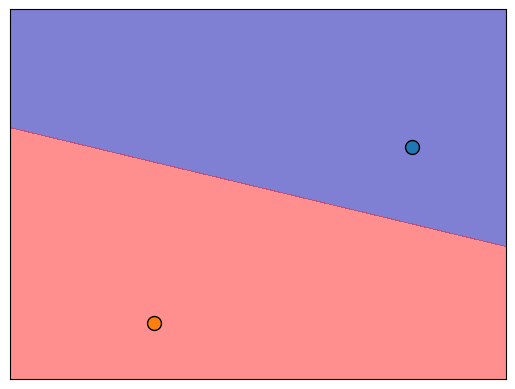
The points are far away from the decision boundary which makes sense.
Over confident cases#
Let’s examine some cases where the model is confident about the prediction but the prediction is wrong.
over_confident_X = X_train[[25, 98]]
over_confident_X
array([[-129.9912, 55.9383],
[-134.4197, 58.3019]])
over_confident_y = y_train[[25, 98]]
over_confident_y
array(['Canada', 'USA'], dtype=object)
probs = lr.predict_proba(over_confident_X)
data_dict = {
"y": over_confident_y,
"y_hat": lr.predict(over_confident_X).tolist(),
"probability score (Canada)": probs[:, 0],
"probability score (USA)": probs[:, 1],
}
pd.DataFrame(data_dict)
| y | y_hat | probability score (Canada) | probability score (USA) | |
|---|---|---|---|---|
| 0 | Canada | Canada | 0.931792 | 0.068208 |
| 1 | USA | Canada | 0.961902 | 0.038098 |
mglearn.discrete_scatter(
over_confident_X[:, 0],
over_confident_X[:, 1],
over_confident_y,
markers="o",
)
mglearn.plots.plot_2d_separator(lr, X_train, fill=True, eps=0.5, alpha=0.5)
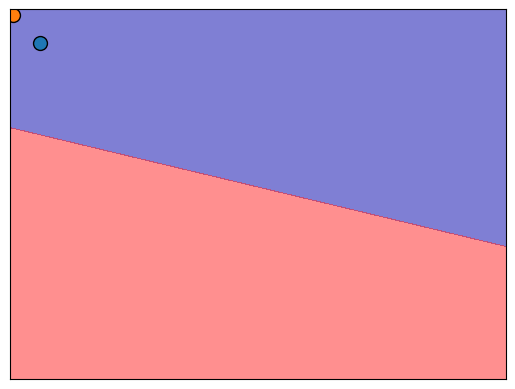
The cities are far away from the decision boundary. So the model is pretty confident about the prediction.
But the cities are likely to be from Alaska and our linear model is not able to capture that this part belong to the USA and not Canada.
Below we are using colour to represent prediction probabilities. If you are closer to the border, the model is less confident whereas the model is more confident about the mainland cities, which makes sense.
fig, axes = plt.subplots(1, 2, figsize=(18, 5))
from matplotlib.colors import ListedColormap
for ax in axes:
mglearn.discrete_scatter(
X_train[:, 0], X_train[:, 1], y_train, markers="o", ax=ax
)
ax.set_xlabel("longitude")
ax.set_ylabel("latitude")
axes[0].legend(["Train class 0", "Train class 1"], ncol=2, loc=(0.1, 1.1))
mglearn.plots.plot_2d_separator(
lr, X_train, fill=True, eps=0.5, ax=axes[0], alpha=0.5
)
mglearn.plots.plot_2d_separator(
lr, X_train, fill=False, eps=0.5, ax=axes[1], alpha=0.5
)
scores_image = mglearn.tools.plot_2d_scores(
lr, X_train, eps=0.5, ax=axes[1], alpha=0.5, cm=plt.cm.coolwarm
)
cbar = plt.colorbar(scores_image, ax=axes.tolist())
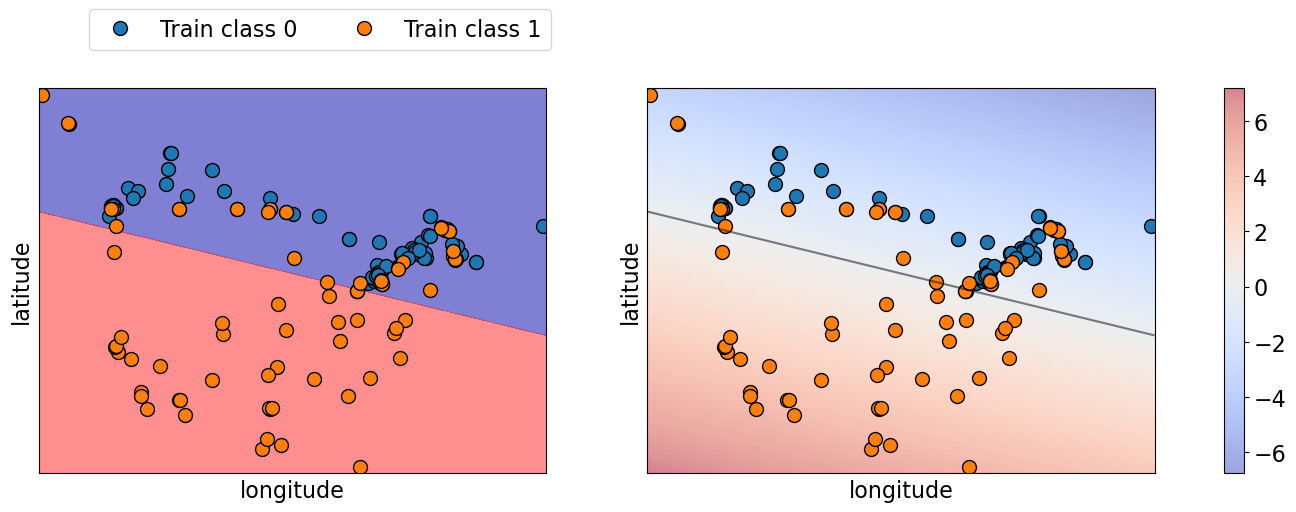
Sometimes a complex model that is overfitted, tends to make more confident predictions, even if they are wrong, whereas a simpler model tends to make predictions with more uncertainty.
To summarize,
With hard predictions, we only know the class.
With probability scores we know how confident the model is with certain predictions, which can be useful in understanding the model better.
❓❓ Questions for you#
(iClicker) Exercise 7.2#
iClicker cloud join link: https://join.iclicker.com/3DP5H
Select all of the following statements which are TRUE.
(A) Increasing logistic regression’s
Chyperparameter increases model complexity.(B) The raw output score can be used to calculate the probability score for a given prediction.
(C) For linear classifier trained on \(d\) features, the decision boundary is a \(d-1\)-dimensional hyperparlane.
(D) A linear model is likely to be uncertain about the data points close to the decision boundary.
Linear SVM#
We have seen non-linear SVM with RBF kernel before. This is the default SVC model in
sklearnbecause it tends to work better in many cases.There is also a linear SVM. You can pass
kernel="linear"to create a linear SVM.
cities_df = pd.read_csv("data/canada_usa_cities.csv")
train_df, test_df = train_test_split(cities_df, test_size=0.2, random_state=123)
X_train, y_train = train_df.drop(columns=["country"]).values, train_df["country"].values
X_test, y_test = test_df.drop(columns=["country"]).values, test_df["country"].values
fig, axes = plt.subplots(1, 2, figsize=(18, 5))
from matplotlib.colors import ListedColormap
for (model, ax) in zip([SVC(gamma=0.01), SVC(kernel="linear")], axes):
mglearn.discrete_scatter(
X_train[:, 0], X_train[:, 1], y_train, markers="o", ax=ax
)
model.fit(X_train, y_train)
ax.set_xlabel("longitude")
ax.set_ylabel("latitude")
mglearn.plots.plot_2d_separator(
model, X_train, fill=True, eps=0.5, ax=ax, alpha=0.5
)
axes[0].set_title("SVM RBF")
axes[1].set_title("Linear SVM");

predictmethod of linear SVM and logistic regression works the same way.We can get
coef_associated with the features andintercept_using a Linear SVM model.
linear_svc = SVC(kernel="linear")
linear_svc.fit(X_train, y_train)
print("Model weights: %s" % (linear_svc.coef_))
print("Model intercept: %s" % (linear_svc.intercept_))
Model weights: [[-0.0195598 -0.23640124]]
Model intercept: [8.22811601]
lr = LogisticRegression()
lr.fit(X_train, y_train)
print("Model weights: %s" % (lr.coef_))
print("Model intercept: %s" % (lr.intercept_))
Model weights: [[-0.04108149 -0.33683126]]
Model intercept: [10.8869838]
Note that the coefficients and intercept are slightly different for logistic regression.
This is because the
fitfor linear SVM and logistic regression are different.
Summary of linear models#
Linear regression is a linear model for regression whereas logistic regression is a linear model for classification.
Both these models learn one coefficient per feature, plus an intercept.
Main hyperparameters#
The main hyperparameter is the “regularization” hyperparameter controlling the fundamental tradeoff.
Logistic Regression:
CLinear SVM:
CRidge:
alpha
Interpretation of coefficients in linear models#
the \(j\)th coefficient tells us how feature \(j\) affects the prediction
if \(w_j > 0\) then increasing \(x_{ij}\) moves us toward predicting \(+1\)
if \(w_j < 0\) then increasing \(x_{ij}\) moves us toward prediction \(-1\)
if \(w_j == 0\) then the feature is not used in making a prediction
Strengths of linear models#
Fast to train and predict
Scale to large datasets and work well with sparse data
Relatively easy to understand and interpret the predictions
Perform well when there is a large number of features
Limitations of linear models#
Is your data “linearly separable”? Can you draw a hyperplane between these datapoints that separates them with 0 error.
If the training examples can be separated by a linear decision rule, they are linearly separable.
A few questions you might be thinking about
How often the real-life data is linearly separable?
Is the following XOR function linearly separable?
$\(x_1\)$ |
$\(x_2\)$ |
target |
|---|---|---|
0 |
0 |
0 |
0 |
1 |
1 |
1 |
0 |
1 |
1 |
1 |
0 |
Are linear classifiers very limiting because of this?
